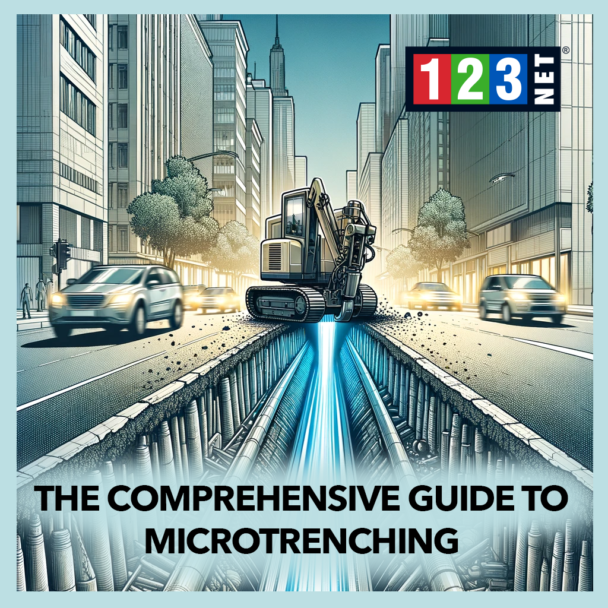
Introduction
Microtrenching is an innovative construction technique primarily used for the deployment of fiber optic cables. It is essential components of modern digital infrastructure. This method involves creating narrow, shallow trenches in existing roadways or sidewalks. This is allowing for quick and efficient conduit installations with minimal surface disruption. As urban areas become denser and the demand for faster connectivity increases, microtrenching offers a viable solution that aligns with both subsurface utility engineering and urban infrastructure development goals. Its significance extends beyond just cable installation, integrating seamlessly with broader trenchless technology practices to enhance utility construction with reduced ground disturbance.
The Microtrenching Process
Microtrenching is renowned for its precision and efficiency, key characteristics that make it an appealing choice for modern urban infrastructure and fiber optic installation. The process initiates with thorough planning, assessing potential routes for utility layouts to avoid conflicts with existing subsurface structures. Compliance with local regulations and subsurface utility engineering protocols is a critical first step. It is ensuring that the microtrenching will not disrupt any hidden utilities or violate any urban development standards.
Microtrenching Machines
The actual trenching is performed using highly specialized equipment tailored for cutting through asphalt and concrete with precision. These microtrenching machines are designed to make a narrow, controlled cut into the ground. This is following the predetermined path with minimal deviation. This accuracy is essential not only for maintaining the structural integrity of the surrounding pavement. It is also for minimizing the amount of debris produced during the process.
Vacuum Excavation Tools
Following the cutting phase, vacuum excavation tools are employed. These tools are crucial for removing the resulting debris from the trench. It is ensuring that the installation space is clean and prepared for the next step. This method of debris removal is preferred as it significantly reduces the disturbance to the surrounding area. It is adhering to best practices in trenchless technology and minimizing ground disturbance.
Cleanup
The installation of conduits follows the cleanup. Durable conduits are laid within the trenches to house and protect the fiber optic cables. This step is critical, as the conduit must be robust enough to withstand external pressures and environmental factors. It is ensuring the long-term functionality of the communication lines it houses.
Restoration
Finally, the restoration phase begins. The trench is carefully refilled, and the asphalt is restored to its original condition, a process known as asphalt restoration. This not only helps to maintain the aesthetic look of the urban landscape but also ensures the integrity of the roadway. It is preventing future complications such as sinkholes or uneven surfaces.
Throughout this process, microtrenching supports efficient cable installation techniques, offering a streamlined approach that is less invasive and more cost-effective compared to traditional methods. It integrates seamlessly into existing urban landscapes, enhancing the deployment of essential technology with minimal environmental impact. The method’s adaptability and reduced scale of operation make it particularly suitable for congested urban environments. Where minimizing disruption and maintaining roadway integrity are paramount.
Advantages of Microtrenching
Microtrenching stands out as a superior choice for urban infrastructure projects due to its numerous benefits. They align seamlessly with the needs of modern, fast-paced urban environments and sustainability goals. Each of its advantages plays a crucial role in not only streamlining the installation of essential services like fiber optics. Also in enhancing urban life by minimizing construction impacts.
Cost-Effectiveness
One of the most compelling benefits of microtrenching is its ability to significantly reduce operational costs. This cost reduction is achieved through less material displacement during the trenching process and the speedier execution of projects. Traditional trenching methods often involve extensive excavation and longer project timelines, both of which inflate costs. In contrast, microtrenching requires narrower and shallower cuts, which reduce the volume of displaced material and thereby lower the material and labor costs associated with removal and restoration.
Speed of Installation
Microtrenching allows projects to be completed much faster than traditional methods. This rapid execution means that the impact on traffic and the daily activities of city residents can be minimized. Faster completion times are not only beneficial in terms of reducing labor costs but also in limiting the duration of any inconvenience to the public and businesses in the affected area.
Reduced Disruption
Unlike broader, more invasive construction methods, microtrenching limits the area of disturbance. This precision helps preserve the integrity of the surrounding environment and public utilities. Preventing the extensive disruptions often associated with large-scale construction projects. The minimal footprint of microtrenching is especially crucial in dense urban settings, where maintaining access and functionality is paramount.
Environmental Benefits
Microtrenching is more sustainable than conventional trenching methods due to its reduced soil disruption and decreased generation of waste materials. These environmental benefits are particularly significant, as they contribute to lower carbon footprints and less environmental degradation. They are aligning with broader goals of environmental stewardship and sustainability.
The combination of these advantages highlights the synergy between microtrenching and sustainable urban development. By offering a method that is not only cost-effective and quick but also environmentally friendly and minimally disruptive, microtrenching significantly enhances its utility in modern construction, making it an optimal method for the deployment of infrastructure in sensitive or densely populated urban areas.
Challenges and Considerations
Despite its numerous advantages, microtrenching does face specific challenges that must be carefully manage to ensure the success of a project. These challenges arise from environmental conditions, the specific settings of the project, and the inherent limitations of the technique itself. Addressing these challenges effectively requires a comprehensive understanding and strategic planning to mitigate potential issues.
Soil Instability
One significant challenge is dealing with unstable soil conditions, which can severely hinder the microtrenching process and impact the integrity of the conduit installation. Unstable or loose soils may collapse or shift, potentially damaging the installed infrastructure or necessitating repeated interventions to secure the trench. This problem requires careful soil assessment before the project begins, choosing appropriate microtrenching methods and equipment that can handle the specific soil type found at the site.
Water Ingress
Another critical issue is managing water ingress, particularly in areas with high groundwater levels or frequent rainfall. Water entering the trenches can complicate the installation process, damage the infrastructure, or lead to future maintenance problems. Effective water management strategies, such as installing proper drainage systems within the trench and using waterproof materials for backfilling and sealing, are essential to prevent water-related complications.
Urban vs. Rural Settings
Microtrenching must adapt to the specific characteristics of urban and rural environments. Urban settings often require more precise execution to avoid disrupting existing utilities. They are typically denser and more complex than in rural areas. Navigating these utilities requires accurate mapping and careful planning to prevent utility strikes, which can cause significant disruption and additional costs. In contrast, rural areas might deal with different challenges such as less stable soil conditions and longer distances, requiring adjustments in equipment and techniques.
To mitigate these issues, several strategies can be done:
- Thorough Pre-Project Planning: This involves detailed mapping and surveys to identify potential obstacles and plan the microtrenching route accordingly.
- Robust Sealing Techniques: Enhancing the durability of the installation with stronger sealing methods can protect the infrastructure from environmental factors like water and soil pressure.
- Continuous Monitoring: Monitoring during and after the installation helps quickly identify and address any issues that arise, ensuring the long-term success of the project.
By addressing these challenges with targeted strategies, the potential of microtrenching can be fully realize, allowing it to continue playing a crucial role in the expansion and enhancement of global infrastructure.

FAQs on Microtrenching
- What is the typical depth and width of a microtrench? A: Typically, a microtrench is about 12-18 inches deep and 1-1.5 inches wide.
- How long does a microtrenching project usually take? A: Duration depends on the project scale but is generally quicker than traditional methods.
- Can microtrenching be used in all types of soil? A: While adaptable, it is most effective in urban settings with stable, less rocky soils.
Conclusion
The future of microtrenching looks promising with ongoing technological advancements enhancing its efficiency and applicability. Innovations in machine precision and multi-utility installation capabilities could further solidify its role in future urban and rural infrastructure projects. As cities continue to grow and the need for rapid, efficient utility updates increases, microtrenching will likely become a standard practice in civil engineering, pushing the boundaries of how modern infrastructure evolves.




